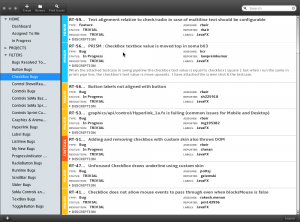FX Experience Has Gone Read-Only
I've been maintaining FX Experience for a really long time now, and I love hearing from people who enjoy my weekly links roundup. One thing I've noticed recently is that maintaining two sites (FX Experience and JonathanGiles.net) takes more time than ideal, and splits the audience up. Therefore, FX Experience will become read-only for new blog posts, but weekly posts will continue to be published on JonathanGiles.net. If you follow @FXExperience on Twitter, I suggest you also follow @JonathanGiles. This is not the end - just a consolidation of my online presence to make my life a little easier!
tl;dr: Follow me on Twitter and check for the latest news on JonathanGiles.net.
by Richard Jasper and Jonathan | Apr 29, 2010 | API Design, Controls
In JavaFX 1.3 a lot of work has gone into ListView, and extracting out the base virtualization engine (the secret sauce to high performance lists) such that it is able to be used in controls such as TreeView and TableView. At the same time we wanted to make it really easy for developers to customize what is shown in each ListView row. What we’ve ended up doing is creating the concept of a cell, which at any point in time represents at most one item in your ListView, and it is through the cell that you have total freedom about how to display your data. Finally, as noted, we’ve expanded this concept to also be used in exactly the same way in TreeView (which is a preview in JavaFX 1.3), and it is likely to also underpin any future TableView control.
(more…)
by Richard Bair | Apr 27, 2010 | Controls, Tips n' Tricks
One of the really neat things about the JavaFX ListView control is the Cell API, and the ability to have dynamically variable row heights, without sacrificing performance or scalability. To accomplish this, we’ll write a custom Cell factory which will create a Cell who’s size depends on some state.
To recap briefly, to remain scalable and fast, the ListView reuses Cells for rendering each row in the ListView. Because it reuses Cells, each Cell needs to be designed so that it does the right thing no matter what row it is asked to represent — even empty rows which are used only for filling out a ListView and not for actually holding valid data. (more…)
by Richard Bair | Jan 12, 2010 | Controls
We have not yet provided a SplitView Control in JavaFX (and it is not in the plan for 1.3). However, the main reason is that it is relatively simple to write one from scratch so we’re focusing on some of the harder things (like TreeViews). I was asked recently how to go about writing a SplitView in JavaFX, so I decided to write a very short blog post with sample code from a demo I wrote for this past Devoxx. (more…)

by Richard Bair | Nov 18, 2009 | Controls, Devoxx, Web Services
In a couple hours Jasper and I will be presenting a talk titled “Enterprising JavaFX” at Devoxx. The main purpose of the talk is to describe how to use JavaFX for writing enterprise application content. Here’s a quick teaser screenshot of one of the apps we’re going to describe:

Jira Dashboard Application
We’ll be writing some additional blog posts over the next few weeks describing various tips n’ tricks as to how we used web services in this app, how we wrote the custom list cells, and so forth.
![Win $2000 in RIA Exemplar Challenge]()
by Jasper Potts | Oct 12, 2009 | Controls, Links, UI Design
Create an application in JavaFX that exemplifies the appearance and behavior of a next-generation enterprise RIA (rich internet application)
See the official announcement for more details on the rules etc. Announcing the JavaFXpert RIA Exemplar Challenge
Announcing the JavaFXpert RIA Exemplar Challenge
I will be judging the entries for their visual design with the help of fellow graphics judge Romain Guy. To help all the designers entering here are a couple of the original designs for the Caspian theme along with links to the photoshop files they were created with. This way you can see the how all the all the controls visuals are contracted using vector shapes and layer effects.

Download Controls.PSD.ZIP

Download Controls Mockup.PSD.ZIP
I also thought maybe some links to sites with good articles on design might be helpful. Most of these are associated with Web Design rather than Application User Interface Design but there is a large amount of cross over and I have not found any good sites on Application User Interface myself.
Here are a few links for inspiration:
by Richard Bair | Sep 25, 2009 | API Design, Controls, Performance
When you have a lot of data to display in a Control such as a ListView, you need some way of virtualizing the Nodes created and used. For example, if you have 10 million data items, you don’t want to create 10 million Nodes. So you create enough Nodes to fill the display dynamically. Because of our heritage in Swing, we know how critical this is for real apps. I got an optimization issue reported this morning on “UI Virtualization”. (more…)





